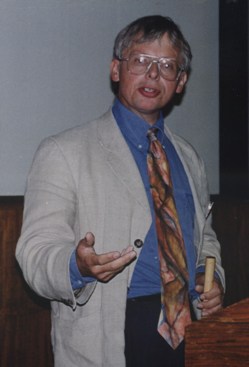
Bruce Yardley* ponders the difference in style between scientists who 'advise' and scientists who 'campaign'.
In January, Cumbria County Council voted to withdraw from the Managing Radioactive Waste Safely (MRWS) process. Local opposition was joined by Professors Stuart Haszeldine and David Smythe, who characterised the geology of west Cumbria as well-known, yet also so unpredictable that finding a safe repository site there was impossible.
Reading these two authors’ web pronouncements1,2, what strikes me is the unambiguous way that cited evidence overwhelmingly supports their position. This lack of uncertainty clearly distinguishes ‘campaigning’ from the sort of technical writing most of us are more used to, which must be measured, and set out the limits of evidence and of authors’ knowledge and competence. And it is easy to see how ‘campaigners’, armed with such apparent certainties, sound more persuasive to a layperson unfamiliar with scientific evidence, while those who show less certainty appear ‘evasive’ (and by implication, ‘Establishment’).
Before the vote, the All-Party Group of Cumbria MPs invited Bruce McKirdy (NDA), Stuart Haszeldine and myself as independent, to meet them. Our written submissions and the transcript can be read online2. Part of our discussion focused on how groundwater flows through possible repository sites near Sellafield. Early work, supervised by Professor Haszeldine, showed water sinking beneath the fells, then rising under the coastal plain3. The final, Nirex work4 contained more data and a more sophisticated groundwater model showing limited, fracture-controlled flow taking place through the Borrowdale Volcanics.
Professor Smythe’s public lecture slides5 present the older, original model, somewhat simplified. The top of the proposed repository is apparently almost at sea level, rather than >500 metres below. Water is shown rising through this hypothetical repository site and discharging on land at artesian springs. Certainly this diagram makes a very clear point; but does it present the full scientific picture? Explaining where he believed the Nirex team went wrong, Smythe writes in his submission2: “My analysis of the modelling used to predict the water flow shows that the effect of the faults cutting the rocks has been ignored”. Ignored? The title of the relevant paper begins with the very words “Fracture-controlled flow”4.
Many radionuclides are only soluble in an oxidised environment. Professor Haszeldine told MPs2: “I consider that there is very solid evidence for oxidising water permeating through the fractures of rocks in this environment – it was measured in boreholes. Where there is evidence of the last minerals to precipitate in many of these faults, there is evidence of oxidising characteristics and glacial water has manifestly gone through these sites to the great depths in question”.
My understanding of those studies6 is that recent iron oxides are only present at shallow levels, above any possible repository. The PODAMOT project7 found some deep, late calcites bearing isotopic evidence of input from glacial sources, but added: “It is very important to note that the calcite with potential glacial δ18O signatures does not correspond to calcite grown under oxidizing conditions as indicated by Ce anomalies or Fe and Mn distribution” [my italics]. Professor Haszeldine is listed as fifth co-author of this paper.
*Bruce Yardley is Professor of Metamorphic Geochemistry at Leeds University, School of Earth and Environment.
REFERENCES
- http://www.davidsmythe.org/nuclear/documents.htm
- http://www.westcumbriamrws.org.uk/page/128/Cumbrian-MPs-fact-finding-session.htm
- McKeown et al., 1999, Engineering Geology 52, 231-250.
- Dengan et al., 2003, Geol Soc Lond Spec Pub 214, 197-219.
- http://www.davidsmythe.org/nuclear/cumbria%20bgs%20exclusion%20report%20review%20for%20website.pdf (slide 4)
- Miladowski et al., 1998, Proc Yorks Geol Soc. 52, 215-242.
- http://www.bgs.ac.uk/padamot/documents.html (WP2 Final Report)